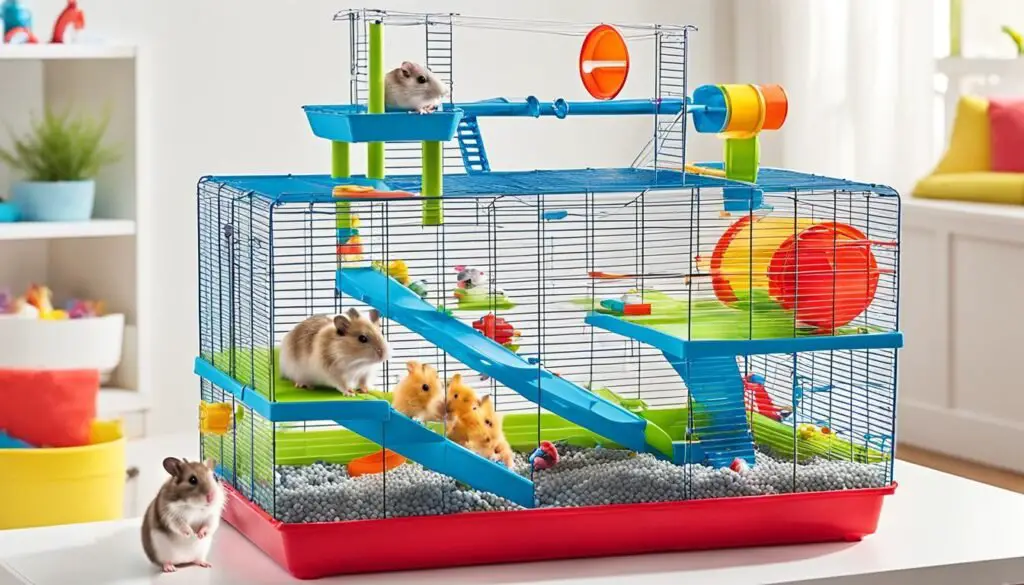Did you know that not all hamsters can live together peacefully? While these adorable furry creatures make great pets, their compatibility with each other varies. If you’re considering housing multiple hamsters, it’s essential to understand which breeds are compatible and how to provide the best living conditions for them. Let’s explore the fascinating world of hamster companionship and discover the housing options that ensure their well-being.
When it comes to hamsters, there are some important factors to consider. Syrian hamsters, for example, are solitary animals and must be kept alone to prevent any conflicts. However, other breeds of hamsters can be paired together, with same-sex pairings being recommended to avoid unexpected breeding.
Pairings and groups should ideally come from the same litter as they are more likely to get along. It’s worth noting that squabbles and fights can be common, especially among male hamsters, so careful monitoring is necessary to ensure their compatibility.
Reputable pet shops can help determine the sex of the hamsters before purchase, further ensuring a harmonious living arrangement. Another important consideration is that different hamster breeds have different needs and requirements, such as size and temperament, which should be taken into account when deciding on their companions.
Stay tuned as we dive deeper into the specific hamster breeds and their compatibility in the upcoming sections. Discover which furry friends can happily coexist and learn valuable tips for housing multiple hamsters to promote their well-being and happiness.
Hamster Breeds and Compatibility
When considering getting hamster companions, it’s important to choose the right hamster breed that can coexist with others. While Syrian hamsters are known for their solitary nature and need to be kept alone, there are other breeds that can live together in pairs or small groups.
Syrian Hamsters: Also known as Golden hamsters, Syrian hamsters should be kept alone as they prefer a solitary lifestyle.
Campbell’s Russian Dwarf Hamsters and Winter White Russian Dwarf Hamsters: These two dwarf hamster breeds can live together in pairs or small groups. They are generally more sociable and can form bonds with their cage mates.
Chinese Hamsters: Chinese hamsters can also live in pairs or small groups. However, it’s important to monitor their behavior closely to ensure there are no signs of aggression or squabbles.
Roborovski’s Hamsters: Being the smallest member of the hamster family, Roborovski’s hamsters can live in groups or pairs. However, due to their active temperaments, they may be more difficult to handle.
Mixing different breeds of hamsters should be avoided as it can lead to aggression, territorial behavior, and fighting. It’s essential to consider the compatibility and size of the hamsters to ensure a harmonious living environment for all.

Tips for Housing Multiple Hamsters
If you are considering introducing hamsters to each other and housing multiple hamsters together, there are some important factors to consider to ensure their well-being and harmonious group dynamics.
First and foremost, it is best to introduce hamsters to each other when they are young. Young hamsters are more adaptable and likely to form positive relationships with their cage mates. This also helps to reduce the chances of aggression and territorial behavior.
Providing a spacious cage is essential for housing multiple hamsters. A larger cage allows each hamster to have their own territory and space. It is recommended to have separate areas for feeding, as well as two of each resource such as food bowls, water bottles, and hamster wheels. This helps to prevent competition and reduce aggression among the hamsters.
Monitoring the hamsters’ behavior is crucial. Regularly observe their interactions and listen for any distressing squeaks or signs of fights. If any aggression or fighting occurs, be prepared to separate the hamsters. Having a backup cage ready can help ensure their safety and well-being.
It’s important to note that while dwarf hamsters can be kept together successfully in small groups, Syrian hamsters should always be kept alone due to their solitary nature. By following these tips, you can create a comfortable and harmonious environment for your hamsters and foster positive group dynamics.
